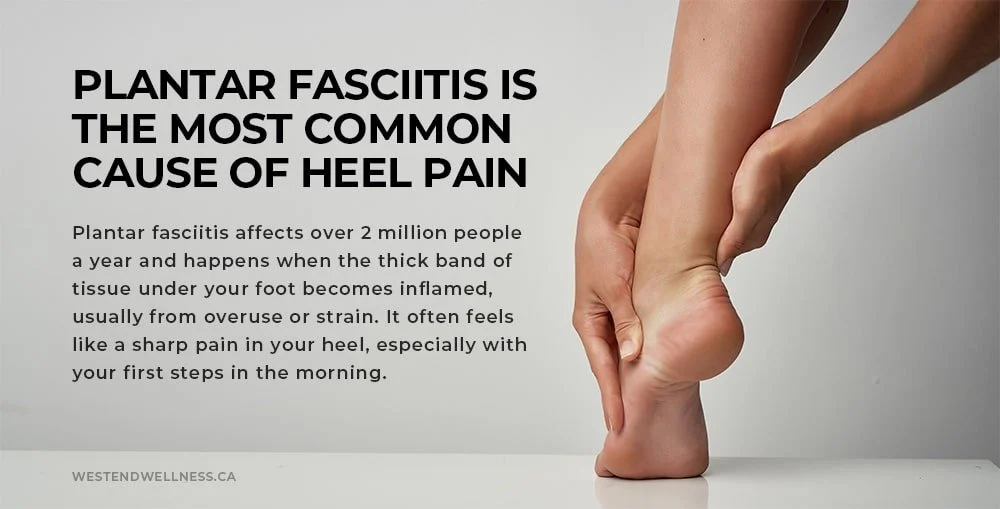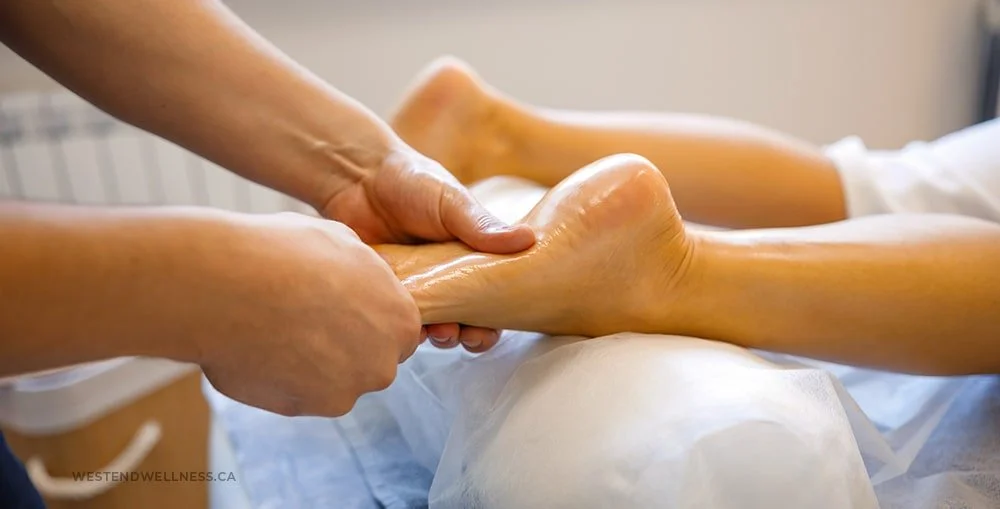Plantar Fasciitis Massage: Relief for Foot Pain Fast
Table of Contents Show
Quick Summary
If you’ve been feeling sharp heel pain, especially in the morning, you might be dealing with plantar fasciitis. This article breaks down what it is, why it happens, and how massage therapy can help relieve the tension and support healing.
You’ll also learn at-home tips like foot rolling, stretching, and choosing the right footwear to ease discomfort. Whether the pain just started or has been around for a while, this guide gives you simple, effective ways to start feeling better and moving comfortably again.
You get out of bed, your feet hit the floor, and the first step sends a sharp pain through your heel.
Maybe it fades a little as you move around, or maybe it sticks with you all day. Either way, it's enough to make walking feel like a chore.
If that sounds familiar, you're not alone. Here in Vancouver, a lot of us are on our feet more than we realize. Whether you're hiking the local trails, chasing kids through the park, or spending long shifts at work, your feet are taking on a lot. And sometimes, they start to fight back.
That kind of pain often turns out to be plantar fasciitis. It doesn’t usually show up all at once. It builds slowly. Maybe your heels felt tight after a long walk. Maybe you brushed it off as just needing new shoes. But over time, that discomfort can turn into something that really gets in the way of your day.
This article is here to help. We’ll talk about what plantar fasciitis is and why it shows up in the first place. We’ll look at how massage therapy can support healing and offer some easy things you can do at home to give your feet a break.
If your heels have been aching, this is a good place to start finding some relief.
What Is Plantar Fasciitis, Anyway?
Plantar fasciitis is one of those things you probably don’t think about until you’ve got it. It’s caused by irritation or small tears in a band of tissue called the plantar fascia. That’s the thick band running along the bottom of your foot, connecting your heel to your toes. It helps support your arch and absorbs the impact every time your foot hits the ground.
When the plantar fascia gets overworked or strained, it can become inflamed. That’s when the pain kicks in. It’s usually felt right at the heel, and it often shows up first thing in the morning or after you’ve been sitting for a while. Some people describe it as a sharp, stabbing feeling. Others say it’s more of a deep ache that just won’t quit.
There’s no single cause, but a few things tend to make it more likely. Wearing shoes with poor support, walking or standing on hard surfaces for long hours, or suddenly increasing your activity level can all play a part. It’s also pretty common in runners, hikers, and people with jobs that keep them on their feet.
Even how you move can be a factor. Tight calves, flat feet, or even the way your hips or knees line up can put extra stress on the bottom of your foot. Over time, that stress builds up, and the fascia starts to get cranky.
The good news? There’s a lot that can be done to help calm things down and get you moving comfortably again. One of those things is massage, which we’ll get into next.
How Massage Can Help with Plantar Fasciitis
When your foot feels like it’s on fire every time you step down, it’s natural to want fast relief. While rest, good footwear, and stretching all play a role, massage therapy is one of those under-the-radar options that can make a big difference.
Massage helps by working into the tight, overworked tissues that are pulling on your heel. A registered massage therapist (RMT) will often focus not just on the bottom of your foot but also on your calves, ankles, and even the muscles around your hips.
Why? Because everything’s connected. Tight calves or weak glutes can throw off how you walk, putting extra pressure on your feet.
A good massage helps increase circulation, reduce inflammation, and calm down that constant tension in your fascia. Some people notice relief after just one session. For others, it takes a few consistent treatments. Either way, massage can help your body heal and give you a break from the day-to-day discomfort.
Common Massage Techniques Used for Plantar Fasciitis
Massage for plantar fasciitis isn't just about rubbing the heel. RMTs often use a mix of techniques depending on what your body needs. A few common ones include:
Deep tissue massage to release stubborn tension in the fascia and surrounding muscles
Myofascial release, which gently stretches the fascia and encourages better mobility
Trigger point therapy to target specific tight spots that might be referring pain into your heel
Cross-fibre friction, which can help break up adhesions and support tissue repair
These techniques can feel intense at times, especially if the area is tender, but a skilled therapist will always work within your comfort zone.
What You Can Do at Home
While regular massage sessions with a professional are great, there’s also a lot you can do at home to support your recovery. The goal is to keep the fascia relaxed, the muscles flexible, and the pressure off your feet as much as possible.
Here are a few easy things to try:
-
Use a massage ball, tennis ball, or even a frozen water bottle to gently roll under your foot for a few minutes a day
-
Pull back on your toes to stretch the fascia and the arch of your foot, especially first thing in the morning
-
Tight calves can pull on the fascia, so stretching your lower legs can help relieve some of that tension
-
Around the house, skip the bare feet. A good pair of supportive indoor shoes or sandals can really help
-
If you’re on your feet a lot, find little moments in your day to sit, stretch, or shift your weight
Consistency is key. Doing a few small things each day can go a long way in calming the pain and keeping it from coming back.
Other Benefits of Massage for Plantar Fasciitis
Massage doesn’t just help with foot pain. It can also support your overall well-being in a few really meaningful ways.
Better Sleep: Massage helps calm your nervous system, which makes it easier to unwind at the end of the day. A relaxed body tends to fall asleep more easily, and stay asleep longer. If your foot pain has been messing with your rest, regular massage can help you get back to a better sleep routine.
Helps with Stress and Low Mood: Living with ongoing pain can be frustrating and even start to wear on your mood. Massage is a simple but powerful way to slow down and reconnect with your body. It gives your nervous system a break and helps ease feelings of anxiety or stress. Many people leave their appointments feeling more grounded and at ease, both physically and mentally.
Supports Your Immune System: When you're stressed, your body puts more energy into staying alert and less into healing. Massage can help bring your stress levels down, which gives your immune system a better chance to do its job. It’s one of those ripple effects — feel more relaxed, and your body can focus more on recovery.
Frequently Asked Questions
Is it OK to massage plantar fasciitis?
Yes, it’s not only OK but it can really help. A gentle massage can ease tension in the fascia, improve blood flow, and reduce pain. Make sure not to press too hard on inflamed areas, especially if the pain is sharp. Start slow and stick with what feels comfortable.
Is there a pressure point to relieve plantar fasciitis?
There isn’t one single magic point, but there are a few areas that often bring relief. One is just in front of your heel, right in the arch of your foot. Another is the calf, especially near the Achilles tendon. Gently working these areas can take some of the strain off your plantar fascia.
How do you self-release plantar fasciitis?
You can roll your foot over a massage ball, tennis ball, or frozen water bottle for a few minutes a day. Focus on the arch and heel area, using slow, steady pressure. Stretching your toes and calves also helps. It’s best to do this consistently, especially in the morning and after long periods of standing.
What are the disadvantages of foot massage?
Foot massage is generally safe, but if you press too hard or massage an area that’s already very inflamed, it could make the pain worse. It’s also important to avoid massage if you have open wounds, infections, or certain circulation issues. When in doubt, check in with a health professional.
How Often Should You Get Massage Therapy for Plantar Fasciitis?
If you have plantar fasciitis, a solid plan is to start with a massage once a week. This gives your body time to respond and helps ease the tension in your feet without overloading them. In some cases, your massage therapist might suggest more frequent sessions at the beginning, especially if the pain is intense or affecting your daily routine.
For the best results, massage should be combined with other treatments like regular stretching, icing, and wearing supportive shoes or insoles. Everyone’s body is different, so it’s a good idea to chat with your massage therapist about what schedule makes the most sense for you. They can help guide you based on how your body is responding and what your day-to-day looks like.
This article explains how acupuncture enhances the immune system by reducing inflammation, boosting immune cells, and promoting relaxation.
Final Thoughts
If you’ve been waking up with that all-too-familiar heel pain or feeling sore after a long day on your feet, you’re not imagining it. Plantar fasciitis is common, and it can sneak into your life without much warning. But that doesn’t mean you’re stuck with it.
We set out to give you a clearer picture of what plantar fasciitis actually is, why it shows up, and most importantly, how you can start feeling better. Massage therapy can play a big role in easing the pain, improving circulation, and helping your body move in a way that doesn’t put extra stress on your feet.
When you combine massage with a few simple at-home practices—like foot rolling, calf stretching, and supportive footwear—you’re setting yourself up for real progress.
Whether you're just starting to notice symptoms or you've been dealing with it for a while, now’s a good time to give your feet a little extra care. Talk to a registered massage therapist, try out a few of the tips we shared, and take it one step at a time. Your heels deserve a break.
If you have any further doubts or questions regarding this subject or another treatment, contact one of our experienced Acupuncturists or Registered Massage Therapists here at West End Wellness Clinic. You can either give us a call or make an appointment.
Disclaimer: Please remember this article is for informational purposes only and should not replace professional medical advice. Please consult a healthcare provider or someone with the correct qualifications before starting any new exercise or treatment program.





